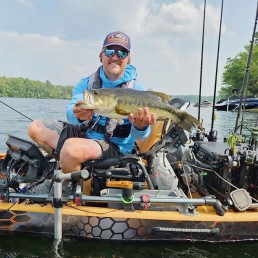Expanding the Wacky Rig
SHARE THIS POST
The 3-pound largemouth is in ambush position, tucked just inside the shoreline reeds, facing outward at the shallow strip of clean bottom bordered by the start of a deeper weed bed. On this medium-sized natural lake, it’s a perfect place to wait for passing bluegills and minnows that become easy meals. Her senses on high alert, she feels and hears a “plip, plip, plip” that sounds like a minnow trying to escape another assailant. Then she sees a longish, worm-looking thing descending slowly from the surface in a horizontal position. Although it looks nothing like a bluegill and is two or three times as long as the minnows she’s used to eating, its attitude is strikingly similar to a baitfish that has just grabbed a mayfly off the surface and is slowly descending while eating the bug.
She attacks, slamming the soft plastic worm broadside.
The angler sitting in the kayak had just side-armed the wacky-rigged Senko on his spinning gear, making it skip right up to the edge of the reeds. The bass’s assault makes his hi-vis, braided line twitch, and he reacts, sweeping back with the 7-foot rod. Fish on!
Perhaps half of all wacky rigs—meaning a soft plastic worm hooked equidistant between the nose and tail—employ the 5-inch Senko or one of its many knockoffs. Many anglers only throw them in water around structure no more than 6 feet deep. But that just scratches the surface of lures and locations for wacky rigs.
Adam Drabek, veteran Michigan kayak bass angler, loves to skip Senkos to shallow cover and under docks and pontoons. But he also lets an unweighted wacky rig slowly sink down into considerably deeper water.
“The deepest I’ve caught a bass is 22 feet down,” Drabek says, and explains the simple technique. “Just toss it out, leave the bail open and let it marinate a couple minutes. You gotta have patience. I watch the line to see if it gets tight or starts moving.”
Speaking of line, Drabek likes 14-pound-test braided line with a 12- to 14-foot leader of 8-pound fluorocarbon. To help subdue big fish with the light leader and to get good hooksets from afar, he employs a 7’ 6” Abu Veritas Tournament spinning rod in medium power.
Drabek rigs his Senko with VMC Crossover Rings: rings designed to be placed in the middle of the lure with special VMC pliers. The rings feature a little nub with molded-in holes. Poke your hook through the hole and no plastic worm is in the hook gap, increasing hooking ability. The “Crossover” name describes how the nubs have two tiny tunnels. Hook one way for a wacky rig; hook the other way for a nose-weighted Neko rig.
Hook selection depends on whether he fishes shallow or deep. For skipping docks and other shallow maneuvers, he pokes a No. 1 or No. 2 Trokar Wacky Hook through.
Are you enjoying this post?
You can be among the first to get the latest info on where to go, what to use and how to use it!
“Smaller is better,” Drabek insists. For deeper presentations, he uses a bigger, heavier hook, like a 2/0 or 3/0 VMC Wacky Hook. Although some wacky hooks have lead “heads” to make lures sink faster, Drabek spurns them, preferring the slow fall. He never uses weedless hooks (lots are on the market) simply because the hooks he uses work well and he’s never found a weedless hook that he likes.
At times, Drabek drop shots a Senko rigged wacky style. The technique drops the stick worm down quickly where it settles just above bottom, maintaining the lure’s horizontal position—and providing bass with the “that look” that gets them to bite.
Some anglers work a wacky rig as if they were flipping or pitching a jig. They cast it to a specific target, let it settle, then reel it back quickly to pitch to the next target. Drabek says working the worm back gets bites, too.
“The lift and reel technique works,” he says. “Bring the bait up two to four feet in the water column and let it shimmy back down.”
While a slowly sinking wacky worm to which you add no action is often the best way to tempt bass, sometimes a little action triggers a bite.
“In shallow water, a little rip and rest to get that shimmy action is money,” Drabek says.
If you want to try a different, exciting fish species or technique, you’ll find plenty of suggestions in every issue of MidWest Outdoors. Subscribe on our website.
MWO
SHARE THIS POST
You may also like...
Nothing found.
Did you enjoy this post?
You can be among the first to get the latest info on where to go, what to use and how to use it!
Dave Mull
Dave Mull of Paw Paw, Mich. has spent his career communicating the outdoors experience and runs Inner Viking Media. He enjoys kayak fishing for anything that swims in the lakes and rivers of the Midwest and beyond, and even uses his MirroCraft, from time to time. Available for seminars.
